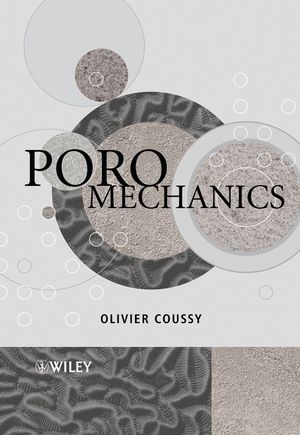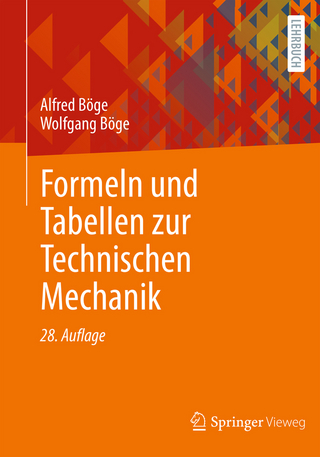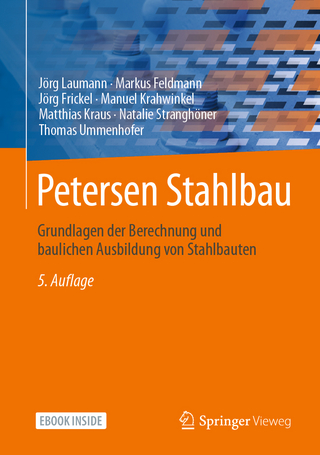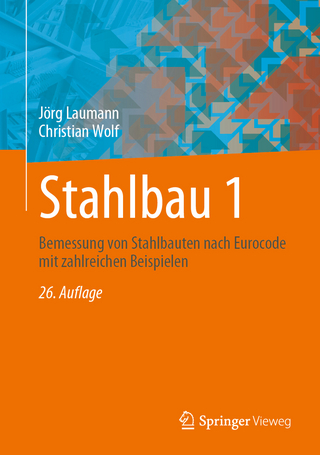
Poromechanics
John Wiley & Sons Inc (Verlag)
978-0-470-84920-0 (ISBN)
Modelling and predicting how porous media deform when subjected to external actions and physical phenomena, including the effect of saturating fluids, are of importance to the understanding of geophysics and civil engineering (including soil and rock mechanics and petroleum engineering), as well as in newer areas such as biomechanics and agricultural engineering. Starting from the highly successful First Edition, Coussy has completely re-written Mechanics of Porous Continua/Poromechanics to include:
New material for:
Partially saturated porous media
Reactive porous media
Macroscopic electrical effects
A single theoretical framework to the subject to explain the interdisciplinary nature of the subject
Exercises at the end of each chapter to aid understanding
The unified approach taken by this text makes it a valuable addition to the bookshelf of every PhD student and researcher in civil engineering, petroleum engineering, geophysics, biomechanics and material science.
Olivier Coussy is the author of Poromechanics, published by Wiley.
Preface. Acknowledgements.
1. Deformation and Kinematics. Mass Balance.
1.1 The Porous Medium and the Continuum Approach.
1.1.1 Connected and Occluded Porosity. The Matrix.
1.1.2 Skeleton and Fluid Particles. Continuity Hypothesis.
1.2 The Skeleton Deformation.
1.2.1 Deformation Gradient and Transport Formulae.
1.2.2 Eulerian and Lagrangian Porosities. Void Ratio.
1.2.3 Strain Tensor.
1.2.4 Infinitesimal Transformation and the Linearized Strain Tensor.
1.3 Kinematics.
1.3.1 Particle Derivative.
1.3.2 Strain Rates.
1.4 Mass Balance.
1.4.1 Equation of Continuity.
1.4.2 The Relative Flow Vector of a Fluid Mass. Filtration Vector. Fluid Mass Content.
1.5 Advanced Analysis.
1.5.1 Particle Derivative with a Surface of Discontinuity.
1.5.2 Mass Balance with a Surface of Discontinuity. The Rankine–Hugoniot Jump Condition.
1.5.3 Mass Balance and the Double Porosity Network.
2. Momentum Balance. Stress Tensor.
2.1 Momentum Balance.
2.1.1 The Hypothesis of Local Forces.
2.1.2 The Momentum Balance.
2.1.3 The Dynamic Theorem.
2.2 The Stress Tensor.
2.2.1 Action–Reaction Law.
2.2.2 The Tetrahedron Lemma and the Cauchy Stress Tensor.
2.3 Equation ofMotion.
2.3.1 The Local Dynamic Resultant Theorem.
2.3.2 The Dynamic Moment Theorem and the Symmetry of the Stress Tensor.
2.3.3 Partial Stress Tensor.
2.4 Kinetic Energy Theorem.
2.4.1 StrainWork Rates.
2.4.2 Piola–Kirchhoff Stress Tensor.
2.4.3 Kinetic Energy Theorem.
2.5 Advanced Analysis.
2.5.1 The Stress Partition Theorem.
2.5.2 Momentum Balance and the Double Porosity Network.
2.5.3 The Tortuosity Effect.
3. Thermodynamics.
3.1 Thermostatics of Homogeneous Fluids.
3.1.1 Energy Conservation and Entropy Balance.
3.1.2 Fluid State Equations. Gibbs Potential.
3.2 Thermodynamics of Porous Continua.
3.2.1 Postulate of Local State.
3.2.2 The First Law.
3.2.3 The Second Law.
3.3 Conduction Laws.
3.3.1 Darcy’s Law.
3.3.2 Fourier’s Law.
3.4 Constitutive Equations of the Skeleton.
3.4.1 State Equations of the Skeleton.
3.4.2 Complementary Evolution Laws.
3.5 Recapitulating the Laws.
3.6 Advanced Analysis.
3.6.1 Fluid Particle Head. Bernoulli Theorem.
3.6.2 Thermodynamics and the Double Porosity Network.
3.6.3 Chemically Active Porous Continua.
4. Thermoporoelasticity.
4.1 Non-linear Thermoporoelastic Skeleton.
4.1.1 Infinitesimal Transformation and State Equations.
4.1.2 Tangent Thermoporoelastic Properties.
4.1.3 The Incompressible Matrix and the Effective Stress.
4.2 Linear Thermoporoelastic Skeleton.
4.2.1 Linear Thermoporoelasticity.
4.2.2 Isotropic Linear Thermoporoelasticity.
4.2.3 Relations Between Skeleton and Matrix Properties.
4.2.4 Anisotropic Poroelasticity.
4.3 Thermoporoelastic Porous Material.
4.3.1 Constitutive Equations of the Saturating Fluid.
4.3.2 Constitutive Equations of the Porous Material.
4.4 Advanced Analysis.
4.4.1 Non-linear Isotropic Poroelasticity.
4.4.2 Brittle Fracture of Fluid-infiltrated Materials.
4.4.3 From Poroelasticity to the Swelling of Colloidal Mixtures.
4.4.4 From Poroelasticity to Chemoelasticity and Ageing Materials.
5. Problems of Poroelasticity.
5.1 Linearized Poroelasticity Problems.
5.1.1 The Hypothesis of Small Perturbations.
5.1.2 Field Equations and Boundary Conditions.
5.1.3 The Diffusion Equation.
5.2 Solved Problems of Poroelasticity.
5.2.1 Injection of a Fluid.
5.2.2 Consolidation of a Soil Layer.
5.2.3 Drilling of a Borehole.
5.3 Thermoporoelasticity Problems.
5.3.1 Field Equations.
5.3.2 Half-space Subjected to a Change in Temperature.
5.4 Advanced Analysis.
5.4.1 Uniqueness of Solution.
5.4.2 The Beltrami–Michell Equations.
5.4.3 Mandel’s Problem.
5.4.4 Non-linear Sedimentation.
6. Unsaturated Thermoporoelasticity.
6.1 Mass andMomentum Balance.
6.1.1 Partial Porosities and Degree of Saturation.
6.1.2 Mass andMomentum Balance.
6.1.3 Mass and Momentum Balance with Phase Change.
6.2 Thermodynamics.
6.2.1 Energy and Entropy Balance for the Porous Material.
6.2.2 Skeleton State Equations. Averaged Fluid Pressure and Capillary Pressure.
6.2.3 Thermodynamics of Porous Media with Phase Change.
6.3 Capillary Pressure Curve.
6.3.1 Energy Approach to the Capillary Pressure Curve.
6.3.2 Capillary Pressure, Natural Imbibition and Isotherm of Sorption.
6.4 Unsaturated Thermoporoelastic Constitutive Equations.
6.4.1 Energy Separation and the Equivalent Pore Pressure Concept.
6.4.2 Equivalent Pore Pressure and Averaged Fluid Pressure.
6.4.3 Equivalent Pore Pressure and Thermoporoelastic Constitutive Equations.
6.4.4 Equivalent Pore Pressure, Wetting and Free Swelling of Materials.
6.5 Heat and Mass Conduction.
6.5.1 Fourier’s Law, Thermal Equation and Phase Change.
6.5.2 Darcy’s Law.
6.5.3 Fick’s Law.
6.6 Advanced Analysis.
6.6.1 The Stress Partition Theorem in the Unsaturated Case.
6.6.2 Capillary Hysteresis. Porosimetry.
6.6.3 Capillary Pressure Curve, Deformation and Equivalent Pore Pressure.
6.6.4 Isothermal Drying of Weakly Permeable Materials.
7. Penetration Fronts.
7.1 Dissolution Fronts.
7.1.1 Mass Balance and Fick’s Law for the Solute.
7.1.2 Instantaneous Dissolution and the Formation of a Penetration Front.
7.1.3 Stefan-like Problem.
7.2 Solute Penetration with Non-linear Binding.
7.2.1 The Binding Process and the Formation of a Penetration Front.
7.2.2 The Time Lag and the Diffusion Test.
7.3 Ionic Migration with Non-linear Binding.
7.3.1 Ionic Migration in the Advection Approximation.
7.3.2 The Travelling Wave Solution.
7.3.3 The Time Lag and the Migration Test.
7.4 Advanced Analysis.
7.4.1 Stefan-like Problem with Non-instantaneous Dissolution.
7.4.2 Imbibition Front.
7.4.3 Surfaces of Discontinuity and Wave Propagation.
8. Poroplasticity.
8.1 Poroplastic Behaviour.
8.1.1 Plastic Strain and Plastic Porosity.
8.1.2 Poroplastic State Equations for the Skeleton.
8.1.3 Poroplastic State Equations for the Porous Material.
8.1.4 Domain of Poroelasticity and the Loading Function Ideal and Hardening Poroplastic Material.
8.2 Ideal Poroplasticity.
8.2.1 The Flow Rule and the Plastic Work.
8.2.2 Principle of Maximal Plastic Work and the Flow Rule. Standard and Non-standard Materials.
8.3 Hardening Poroplasticity.
8.3.1 Hardening Variables and Trapped Energy.
8.3.2 Flow Rule for the Hardening Material. Hardening Modulus.
8.4 Usual Models of Poroplasticity.
8.4.1 Poroplastic Effective Stress.
8.4.2 Isotropic and Kinematic Hardening.
8.4.3 The Usual Cohesive–Frictional Poroplastic Model.
8.4.4 The Cam–Clay Model.
8.5 Advanced Analysis.
8.5.1 Uniqueness of Solution.
8.5.2 Limit Analysis.
8.5.3 Thermal and Chemical Hardening.
8.5.4 Localization of Deformation.
9. Poroviscoelasticity.
9.1 Poroviscoelastic Behaviour.
9.1.1 Viscous Strain and Viscous Porosity.
9.1.2 Poroviscoelastic State Equations for the Skeleton.
9.1.3 Complementary Evolution Laws.
9.2 Functional Approach to Linear Poroviscoelasticity.
9.2.1 Creep Test. Instantaneous and Relaxed Properties. The Trapped Energy.
9.2.2 Creep and Relaxation Functions.
9.2.3 Poroviscoelastic Properties and Constituent Properties.
9.3 Primary and Secondary Consolidation.
9.4 Advanced Analysis.
9.4.1 Poroviscoplasticity.
9.4.2 Functional Approach to the Thermodynamics of Poroviscoelasticity.
A. Differential Operators.
A.1 Orthonormal Cartesian Coordinates.
A.2 Cylindrical Coordinates.
A.3 Spherical Coordinates.
Bibliography.
Index.
| Erscheint lt. Verlag | 9.12.2003 |
|---|---|
| Verlagsort | New York |
| Sprache | englisch |
| Maße | 174 x 253 mm |
| Gewicht | 709 g |
| Themenwelt | Technik ► Bauwesen |
| Technik ► Maschinenbau | |
| ISBN-10 | 0-470-84920-7 / 0470849207 |
| ISBN-13 | 978-0-470-84920-0 / 9780470849200 |
| Zustand | Neuware |
| Informationen gemäß Produktsicherheitsverordnung (GPSR) | |
| Haben Sie eine Frage zum Produkt? |
aus dem Bereich


